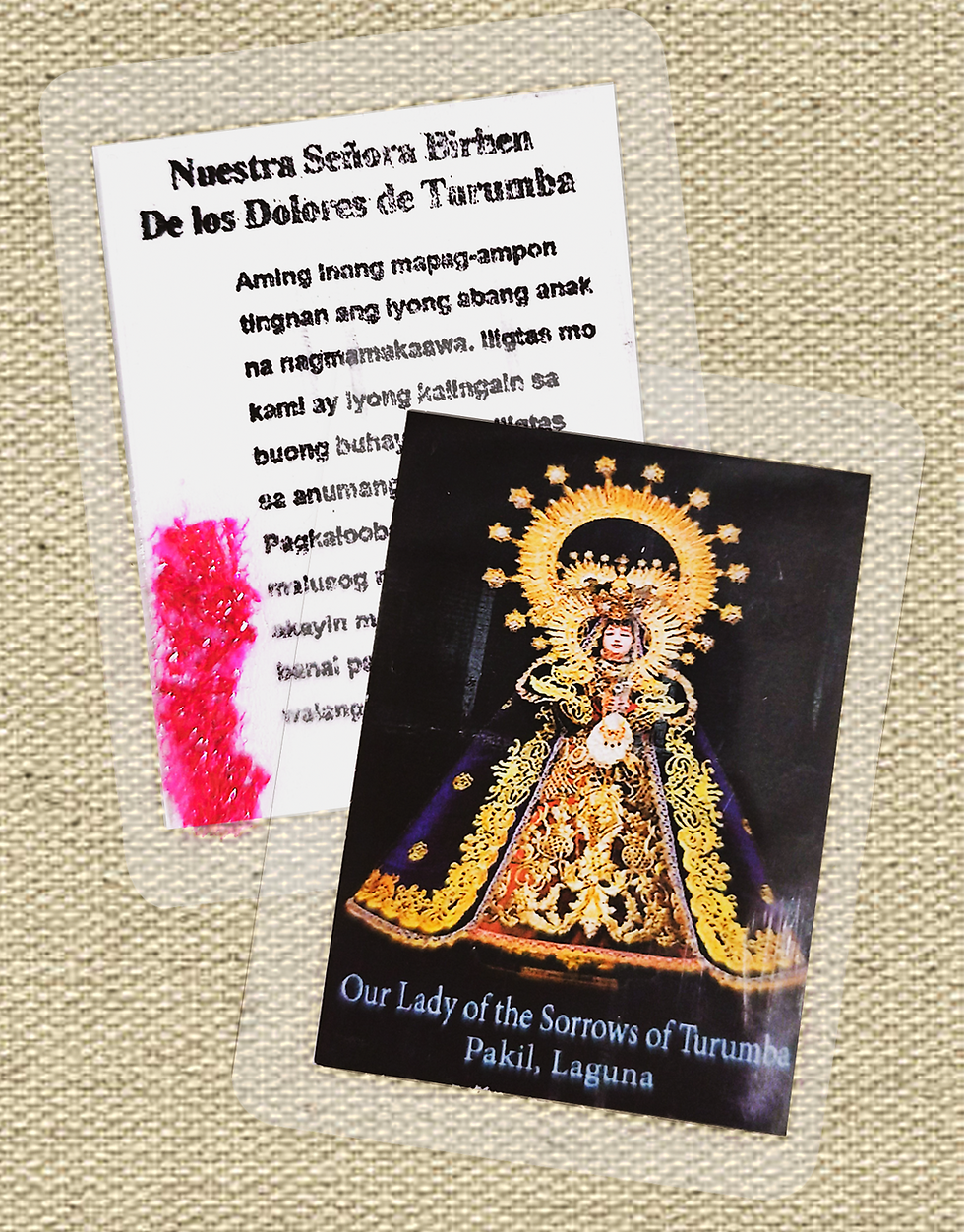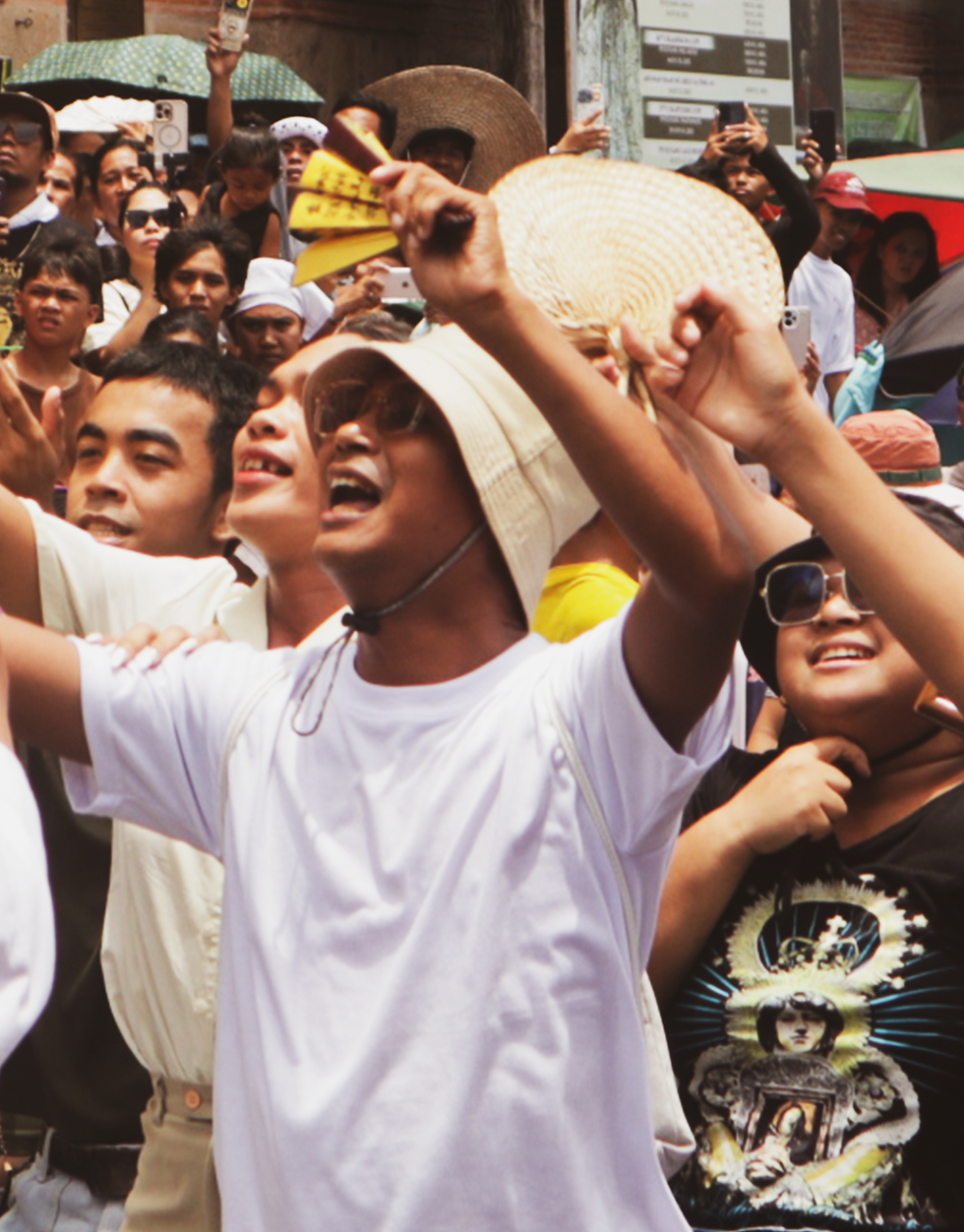
COLLECTION
Cultural Expression
The Turumba Collection
The Turumba devotion of Pakil, Laguna represents a deep connection between faith, tradition, and community identity. Through sacred objects, rituals, and creative expressions, the Turumba devotion shows the distinct way
the people of Pakil honor the Blessed Virgin and preserve their heritage.

Sacred objects, such as the original oil painting of the Virgin and centuries-old religious images, are carefully preserved in the church and brought out during special processions and ceremonies.
Through generations, the people of Pakil have also maintained traditional songs, dances, and artisanal crafts associated with the Turumba by actively involving local communities in festival preparations and handing down these practices as part of their shared cultural heritage.
Symbolic Expressions
Symbolic expressions are forms of intangible cultural heritage that convey meaning, beliefs, or shared values through non-verbal elements, such as rituals, gestures, or visual symbols. These expressions reflect a community's identity and are passed down through generations, helping preserve traditions and strengthen social bonds.
The following are the symbolic expressions found in the Turumba:

It refers to the clothing or vestments used to dress the image of the Blessed Virgin Mary in the Turumba devotion. Usually, the clothes are in solemn colors such as violet or black to symbolize sorrow. The clothes are periodically changed during the festivities, and the old pieces are cut and distributed to the faithful who hold them as tokens of faith and sources of spiritual safety.
04
Damit ng Birhen
Symbolic Expressions

It is the holy oil used in the Turumba devotion for anointing the image of the Blessed Virgin Mary. It is considered sacred by the devotees and is believed to heal ailments such as stomach pain, headaches, and toothaches. It is made from a mixture of coconut oil, wintergreen, and perfume and is considered an effective remedy by many devotees.
05
Banal na Langis
Symbolic Expressions

The image of Our Lady of Sorrows of Turumba is a 9x11 inch oil painting that shows the Virgin Mary with a sorrowful expression and a dagger piercing her heart, symbolizing her suffering. This painting is enshrined in the parish church of Pakil and is an object of devotion during the annual Turumba celebrations.
01
Image of the Turumba
Symbolic Expressions

The "andas" is a decorated wooden carriage used to carry the image of Our Lady of Sorrows of Turumba during processions. It is lifted and carried on the shoulders of devotees as a sign of reverence and thanksgiving during festivities. It is made of metal and glass case measuring about five and a half feet square, surrounded by flowers.
02
Andas
Symbolic Expressions

A distinct chant used repeatedly as an expression and battle cry among the people of Pakil during Turumba processions. It is a form of vocal devotion expressed through song and shouted calls by the faithful. This chant started from the discovery of the iconic image of Our Lady of Turumba in 1788.
03
Sa Birhen!
Symbolic Expressions
Arts and Crafts
Arts and crafts refer to handmade objects that combine the skill and creativity of the people. In religious contexts, these works include items like vestments, sculptures, and ritual implements that carry symbolic meaning and serve functional or ceremonial purposes.
The following are the examples related in the Turumba:

It is a traditional craft which involves carving and shaping soft woods like lanite or batikuling into delicate decorative items such as flowers, birds, and fans. These handcrafted pieces are often given as tokens and souvenirs to guests during Turumba festival, helping promote Pakil’s local products.
01
Wood Whittling
Arts and Crafts

The "Birhen-Birhenan” or Turumba cookies are a vanishing tradition in Pakil. These thin, sweet wafers resemble a communion host and are shaped by hand to resemble the silhouette of Our Lady of Turumba. These cookies are a local specialty that are once sold during the Lupi and given as pasalubong to those unable to attend the Turumba.
02
Birhen-Birhenan
Arts and Crafts

In Pakil, táka refers to the traditional papier-mâché craft known for its colorful, handmade figures such as paper dolls, carabaos, horses, roosters, and other animals that are part of the town's folk art tradition. These are closely associated with Paete, a neighboring town famous for its woodcarving and "taka" craftsmanship.
03
Táka
Arts and Crafts
Music and Dance
Music and dance are integral parts of cultural and religious celebrations, serving as forms of expression that communicate emotions, stories, and communal identity. They often involve rhythmic sounds and coordinated movements that enhance rituals, create joy, and unite participants. In many traditions, music and dance are used to honor deities, celebrate significant events, and preserve cultural heritage.

The Turumba dance traces its roots to the “tatarin”, an early form of religious dance performed in honor of sacred images. According to local stories, the original Turumba had no fixed choreography; devotees simply danced freely in joy and devotion.
When Pakil was invited to perform at Nayong Filipino, Ka Iñigo Vito created a set of unified dance steps to accompany the song "Awit sa Turumba." These movements were designed to match the lyrics and rhythm of the hymn, forming the basis of the Turumba dance steps still performed today. While older generations recall the dance as more spontaneous and frenzied, it has since evolved into a coordinated expression of praise.
The Bands
The town of Pakil is home to four local bands: Banda Uno, Banda Dos, Banda Dose, and the newly formed Maestro Marcelo Adonay (MMA) Band. These bands play a vital role in the community, especially during the Turumba Festival, where they bring energy and spirit to every procession.
The bands also take part in the kampanaryo, held on the eve of each Turumba, where bells and bands alternate in performance for an hour, creating a festive call that signals tomorrow’s Turumba celebration.
Music
Music is defined as a vital element of the Turumba that accompanies the ritual dance and devotional activities. It is characterized by rhythmic drumbeats and traditional songs that set the pace and mood for both communal worship and celebration. Music in Pakil connects the community to their faith, enhances the ceremonial experience, and expresses collective joy and reverence for the Virgin Mary.
There are two music in Turumba:

01
Awit sa Turumba
Professor Julian Balita

02
Makisaya sa Pakil
Dean Antonio Africa (UST conservatory of Music)
1. Makisaya sa Pakil - The music of the Turumba Festival reflects the history and culture of Pakil. Its lyrics weave together the town’s symbols and stories such as the iboli, ping-as, wittling, espasol, Padiok, Quilar, and Adonay. The melody begins slow and solemn, recalling the discovery of Our Lady of Turumba in Laguna de Bay, then rises into a lively rhythm that mirrors the energy of the Turumba dance.
2. Awit sa Turumba - This music is an essential part of the Turumba procession. It was composed by local maestros who added melody and lyrics to express the town’s joy and devotion. Its melody was based on the composition of Professor Julian Balita, who carries a lively swing tempo that encourages dancing, clapping, and jumping as devotees accompany the procession of the Virgin.
Copyright © Turumba Experience. | All Rights Reserved.

